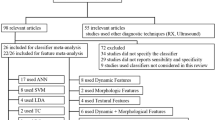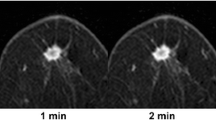Abstract
The accuracy of computer-aided diagnosis (CAD) for early detection and classification of breast cancer in dynamic contrast-enhanced magnetic resonance imaging (DCE-MRI) is dependent upon the features used by the CAD classifier. Here, we show that fast orthogonal search (FOS), which provides a more efficient iterative manner of computing stepwise regression feature selection, can select features with predictive value from a set of kinetic and texture candidate features computed from dynamic contrast-enhanced magnetic resonance images. FOS can in minutes search candidate feature sets of millions of terms, which may include cross-products of features up to second-, third- or fourth-order. This method is tested on a set of 83 DCE-MRI images, of which 20 are for cancerous and 63 for benign cases, using a leave-one-out trial. The features selected by FOS were used in a FOS predictor and nearest-neighbour predictor and had an area under the receiver operating curve (AUC) of 0.889 and 0.791 respectively. The FOS predictor AUC is significantly improved over the signal enhancement ratio predictor with an AUC of 0.706 (p = 0.0035 for the difference in the AUCs). Moreover, using FOS-selected features in a support vector machine increased the AUC over that resulting when the features were manually selected.



Similar content being viewed by others
References
Nass SJ, Henderson IC, Lashof JC, National Cancer Policy Board (U.S.). Committee on Technologies for the Early Detection of Breast Cancer., National Cancer Policy Board (U.S.). Committee on the Early Detection of Breast Cancer: Mammography and beyond: Developing technologies for the early detection of breast cancer. National Academy Press, Washington, DC, 2001
Curry SJ, Byers T, Hewitt M: Fulfilling the potential of cancer prevention and early detection: National Academies Press, 1 edition. (May 21, 2003), 2003
Warner E, Plewes DB, Hill KA, Causer PA, Zubovits JT, Jong RA, Cutrara MR, DeBoer G, Yaffe MJ, Messner SJ, Meschino WS, Piron CA, Narod SA: Surveillance of BRCA1 and BRCA2 mutation carriers with magnetic resonance imaging, ultrasound, mammography, and clinical breast examination. JAMA 292:1317–1325, 2004
Leach MO, Boggis CR, Dixon AK, Easton DF, Eeles RA, Evans DG, Gilbert FJ, Griebsch I, Hoff RJ, Kessar P, Lakhani SR, Moss SM, Nerurkar A, Padhani AR, Pointon LJ, Thompson D, Warren RM: Screening with magnetic resonance imaging and mammography of a UK population at high familial risk of breast cancer: a prospective multicentre cohort study (MARIBS). Lancet 365:1769–1778, 2005
Kriege M, Brekelmans CT, Boetes C, Besnard PE, Zonderland HM, Obdeijn IM, Manoliu RA, Kok T, Peterse H, Tilanus-Linthorst MM, Muller SH, Meijer S, Oosterwijk JC, Beex LV, Tollenaar RA, de Koning HJ, Rutgers EJ, Klijn JG: Efficacy of MRI and mammography for breast-cancer screening in women with a familial or genetic predisposition. N Engl J Med 351:427–437, 2004
Lehman CD, Gatsonis C, Kuhl CK, Hendrick RE, Pisano ED, Hanna L, Peacock S, Smazal SF, Maki DD, Julian TB, DePeri ER, Bluemke DA, Schnall MD: MRI evaluation of the contralateral breast in women with recently diagnosed breast cancer. N Engl J Med 356:1295–1303, 2007
Pediconi F, Catalano C, Roselli A, Padula S, Altomari F, Moriconi E, Pronio AM, Kirchin MA, Passariello R: Contrast-enhanced MR mammography for evaluation of the contralateral breast in patients with diagnosed unilateral breast cancer or high-risk lesions. Radiology 243:670–680, 2007
Saslow D, Boetes C, Burke W, Harms S, Leach MO, Lehman CD, Morris E, Pisano E, Schnall M, Sener S, Smith RA, Warner E, Yaffe M, Andrews KS, Russell CA: American Cancer Society guidelines for breast screening with MRI as an adjunct to mammography. Ca-a Cancer Journal for Clinicians 57:75–89, 2007
Sardanelli F, Podo F: Breast MR imaging in women at high-risk of breast cancer. Is something changing in early breast cancer detection? Eur Radiol 17:873–887, 2007
Lucht REA, Knopp MV, Brix G: Classification of signal-time curves from dynamic MR mammography by neural networks. Magn Reson Imaging 19:51–57, 2001
Gibbs P, Liney GP, Lowry M, Kneeshaw PJ, Turnbull LW: Differentiation of benign and malignant sub-1 cm breast lesions using dynamic contrast enhanced MRI. Breast 13:115–121, 2004
Schnall MD, Blume J, Bluemke DA, DeAngelis GA, DeBruhl N, Harms S, Heywang-Kobrunner SH, Hylton N, Kuhl CK, Pisano ED, Causer P, Schnitt SJ, Thickman D, Stelling CB, Weatherall PT, Lehman C, Gatsonis CA: Diagnostic architectural and dynamic features at breast MR imaging: multicenter study. Radiology 238:42–53, 2006
Vomweg TW, Buscema M, Kauczor HU, Teifke A, Intraligi M, Terzi S, Heussel CP, Achenbach T, Rieker O, Mayer D, Thelen M: Improved artificial neural networks in prediction of malignancy of lesions in contrast-enhanced MR-mammography. Med Phys 30:2350–2359, 2003
Szabo BK, Wiberg MK, Bone B, Aspelin P: Application of artificial neural networks to the analysis of dynamic MR imaging features of the breast. Eur Radiol 14:1217–1225, 2004
Chen WJ, Giger ML, Lan L, Bick U: Computerized interpretation of breast MRI: investigation of enhancement-variance dynamics. Med Phys 31:1076–1082, 2004
Mu T, Nandi AK, Rangayyan RM: Classification of breast masses using selected shape, edge-sharpness, and texture features with linear and kernel-based classifiers. J Digit Imaging 21:153–169, 2008
Sahiner B, Chan HP, Petrick N, Helvie MA, Goodsitt MM: Design of a high-sensitivity classifier based on a genetic algorithm: application to computer-aided diagnosis. Phys Med Biol 43:2853–2871, 1998
Draper NR, Smith H: Applied regression analysis. Wiley, New York, 1998
Korenberg MJ: Fast orthogonal algorithms for nonlinear system identification and time-series analysis. Advanced Methods of Physiological System Modeling 2:165–179, 1989
Minz I, Korenberg MJ: Modeling cooperative gene regulation using fast orthogonal search. The Open Bioinformatics Journal 2:80–89, 2008
Shirdel E, Korenberg M, Madarnas Y: Neutropenia prediction based on first-cycle blood counts using a FOS-3NN classifier. Advances in Bioinformatics 2011:1–8, 2011
Korenberg MJ: Fast Orthogonal Identification of Nonlinear Dif2ference Equation and Functional Expansion Models. Proceedings of Midwest Symposium on Circuits and Systems: Syracuse, NY 1987
Korenberg MJ: A robust orthogonal algorithm for system identification and time-series analysis. Biological Cybernetics 60:267–276, 1989
MatLab Statistics Toolbox 7.5 User's Guide, Nantick, MA: The MathWorks Inc., 2011
Shirdel E, Korenberg MJ, Madarnas Y: Use of fast orthogonal search to predict chemotherapy-induced leukopenia. Journal of Clinical Oncology, 2005 {ASCO} Annual Meeting Proceedings 23, 2005
Warner E, Plewes DB, Hill KA, Causer PA, Zubovits JT, Jong RA, Cutrara MR, DeBoer G, Yaffe MJ, Messner SJ, Meschino WS, Piron CA, Narod SA: Surveillance of BRCA1 and BRCA2 mutation carriers with magnetic resonance imaging, ultrasound, mammography, and clinical breast examination. JAMA: Journal of the American Medical Association 292:1317–1325, 2004
Martel AL, Froh MS, Brock KK, Plewes DB, Barber DC: Evaluating an optical-flow-based registration algorithm for contrast-enhanced magnetic resonance imaging of the breast. Physics in Medicine and Biology 52:3803–3816, 2007
Fienup JR: Invariant error metrics for image reconstruction. Applied Optics 36:8352–8352, 1997
Hylton N: Dynamic contrast-enhanced magnetic resonance imaging as an imaging biomarker. J Clin Oncol 24:3293–3298, 2006
Levman J, Leung T, Causer P, Plewes D, Martel AL: Classification of dynamic contrast-enhanced magnetic resonance breast lesions by support vector machines. IEEE Transactions on Medical Imaging 27:688–696, 2008
Vapnik V: The nature of statistical learning theory. Springer, New York, 2000
Hanley JA, McNeil BJ: A method of comparing the areas under receiver operating characteristic curves derived from the same cases. Radiology 148:839–843, 1983
Metz CE, Herman BA, Roe CA: Statistical comparison of two ROC-curve estimates obtained from partially-paired datasets. Medical decision making: an international journal of the Society for Medical Decision Making 18:110–121, 1998
ROC-KIT Beta Version. Available at http://metz-roc.uchicago.edu/MetzROC. Accessed 30 April 2012
Acknowledgements
The authors acknowledge Dr. Ellen Warner, Associate Scientist, Sunnybrook Health Sciences Centre, Toronto, ON, Canada, and the Canadian Breast Cancer Research Association for providing the DCE-MRI images used in this study. The authors thank the reviewers for their constructive comments on the manuscript.
Grants
NSERC Discovery Grants, DRM and MJK
Author information
Authors and Affiliations
Corresponding author
Appendix
Appendix
The 5 acquired volumes are referred to as the raw image (I raw (x, y, n)) and given by.
The enhanced images I en (x, y, n) and difference images I dif (x, y, n) were respectively generated by:
and
where s(x, y, n) represents the post-contrast image at time n, for n = 1,…,4 and s(x, y, 0) is the precontrast image at coordinates (x, y).
The washout measures how quickly the contrast agent leaves the tissue and is computed on a pixel-by-pixel basis as
For the derivative, the sample difference is given by
The maximum and mean W.O. and derivative in the ROI are used as features. The signal enhancement ratio (SER) was computed on a pixel-by-pixel basis given by the equation
The correlation coefficient between vector x and y is given by
where x i and y i are the ith elements, \( \overline {\text{x}} \) and \( \overline {\text{y}} \) are the sample means (of that vector’s elements), and σ x and σ y are the sample standard deviations of x and y respectively.
Rights and permissions
About this article
Cite this article
Rakoczy, M., McGaughey, D., Korenberg, M.J. et al. Feature Selection in Computer-Aided Breast Cancer Diagnosis via Dynamic Contrast-Enhanced Magnetic Resonance Images. J Digit Imaging 26, 198–208 (2013). https://doi.org/10.1007/s10278-012-9506-2
Published:
Issue Date:
DOI: https://doi.org/10.1007/s10278-012-9506-2




